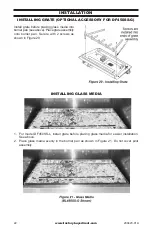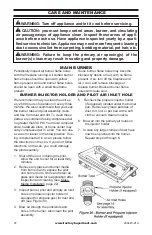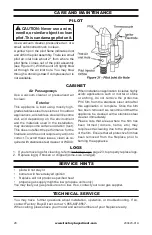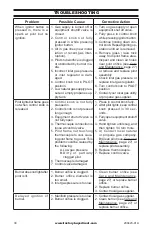
www.factorybuysdirect.com
200423-01A
27
WARNING: Turn off appliance and let it cool before servicing.
CAUTION: you must keep control areas, burner, and circulating
air passageways of appliance clean. Inspect these areas of appli-
ance before each use. Have appliance inspected yearly by a quali
-
fied service technician. Appliance may need more frequent cleaning
due to excessive lint from carpeting, bedding material, pet hair, etc.
WARNING: Failure to keep the primary air opening(s) of the
burner(s) clean may result in sooting and property damage.
CARE AND MAINTENANCE
MAIN BURNER
Periodically inspect all burner flame holes
with the fireplace running. All slotted burner
flame holes should be open with yellow
flame present. All round burner flame holes
should be open with a small blue flame
present.
Some burner flame holes may become
blocked by debris or rust, with no flame
present. If so, turn off the fireplace and
let it cool, and remove blockage or
replace burner. Blocked burner flame
holes will create soot.
BURNER INJECTOR HOLDER AND PILOT AIR INLET HOLE
We recommend that you clean the unit ev
-
ery 2,500 hours of operation or every three
months. We also recommend that you keep
the burner tube and pilot assembly clean
and free from dust and dirt. To clean these
parts we recommend using compressed air
no greater than 30 PSI. Your local computer
store, hardware store, or home center may
carry compressed air in a can. You can use
a vacuum cleaner in the blow position. If us
-
ing compressed air in a can, please follow
the directions on the can. If you don't follow
directions on the can, you could damage
the pilot assembly.
1.
Shut off the unit, including the pilot.
Allow the unit to cool for at least thirty
minutes.
2.
Remove any glass and burner media
from burner pan to expose the pilot
and burner ports. Store and retain all
glass and media for reapplication after
inspection and cleaning (see Glass
Media Installation, page 22).
3.
Inspect burner, pilot and primary air inlet
holes on propane injector holder (if
equipped for propane gas) for dust and
dirt (see Figure 30).
4.
Blow air through the ports/slots and
holes in the burner. Also clean the pilot
assembly.
5.
Recheck the propane injector holder
(if equipped) located under the burner
pan. Remove any large particles of
dust, dirt, lint, or pet hair with a soft
cloth or vacuum cleaner nozzle.
6.
Blow air into the primary air holes on
the injector holder
7.
In case any large clumps of dust have
now been pushed into the burner.
Repeat steps 4 through 6.










































